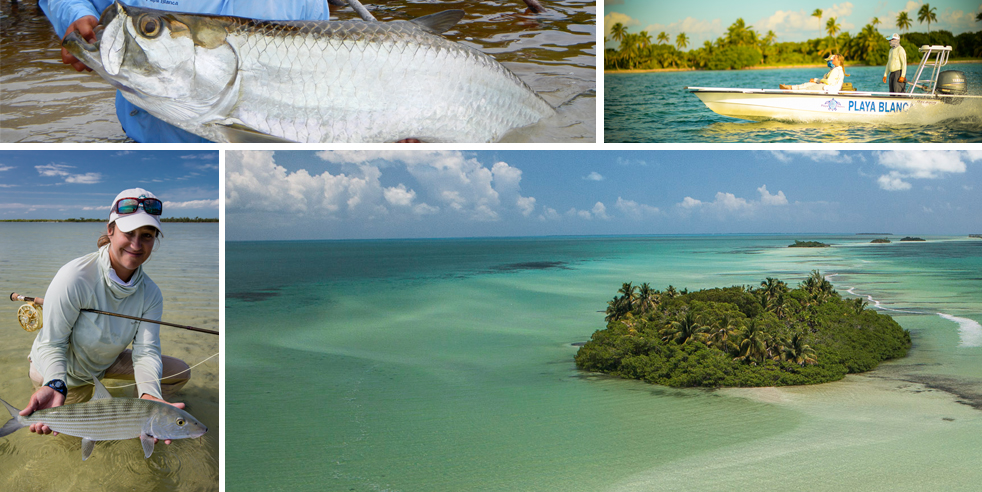At Casa Blanca permit water is endless, and the creek and river inlets in the back of the bay can keep a snook and tarpon fisherman busy for days.
Fast becoming an adventure spot on every saltwater anglers bucket list, Ascension Bay is a place where all of the stars align. Possibly the best location in the world to accomplish a fly fishing grand slam, the bay is teeming with all of the flats species year-round. From rivers, lagoons and classic sand flats, there are endless possibilities to wade or fish from the boat.
Situated one hundred miles to the south of Cancun and covering over eight-hundred square miles, Ascension Bay sticks out on the map. Numerous perfect bonefish flats dot the bay, the permit water is endless, and the creek and river inlets in the back of the bay can keep a snook and tarpon fisherman busy for days. Runs from the lodge to the fishing can be anywhere from five minutes to over an hour.
Espiritu Santo Bay lies off the southern tip of Punta Pájaros. Often referred to as the last frontier of Yucatan flats fishing, Espiritu Santo is difficult to reach from anywhere other than Playa Blanca Lodge. At approximately half the width of Ascension Bay, Espiritu Santo is a smaller but equally impressive fishery. Multiple river systems pour into the bay over limestone bottoms, depositing an area of rich sediment that bonefish and permit are often found tailing in. The mangroves that line these rivers provide perfect habitat for tarpon and snook and an ideal situation for a super grand slam. The bay itself is edged by vast sand flats, perfect for wading, while the deeper water can be a great place to find cruising permit schools. Due to the remoteness of Espiritu Santo Bay, fishing pressure remains light. A local lobster boat or one of your lodge mates is usually the only traffic you will see while out on the water. Runs to the fishing can be anywhere from fifteen minutes to an hour.
The expansive mangrove estuary of Ascension Bay known as the Santa Rosa Lagoon lies due west of Punta Pájaros. A massive system of linked small and medium lagoons, Santa Rosa is an important area to the ecosystem, harboring and nurturing juvenile fish and other sea life. Fishing is endless in this beautiful backcountry. An impressive number of juvenile tarpon, some up to fifty pounds, call Santa Rosa home, as do the area’s larger bonefish specimens, barracuda and snook. Santa Rosa offers excellent protection from the wind and is a great option for those tougher days on the flats. Santa Rosa is also a wonderful place for wildlife viewing, home to amazing birds like the boat-billed heron, roseate spoonbill, reddish egret, tiger heron, and pygmy kingfisher.
Species
Bonefish are plentiful in our waters, and found everywhere but the deeper recesses of the Santa Rosa Lagoon. While this area was once famous for large numbers of smaller bonefish, that reputation is slowly changing. Thanks to conservation efforts and with the passage of time, our bonefish are getting bigger. It is now fairly common to see fish over five pounds, with fish close to the ten pound mark caught every season. From hard sand flats to mangrove lagoons, there is plenty of habitat for the biosphere’s grey ghost. Our home flat right in front of Casa Blanca is a perfect place to test your skills on our resident school of bonefish, anywhere from three to eight pounds.
The permit fishing at Casa Blanca & Playa Blanca is quite possibly the best in the world, thanks to thriving fish populations under the protection of the biosphere. By far the most difficult fish you’ll encounter on the flats, permit have superb eyesight and a well-developed sense of smell. Although it is fairly common to see permit with their tail and dorsal fin out of the water, they usually won’t remain there for long. They’re constantly on the move, so quick, accurate casts (and luck) are essential. Don’t become discouraged with a few refusals. Permit are difficult but catchable. With the help of our guides, anglers boat them every week of the season.
Tarpon are the largest, strongest and most acrobatic of the flats lineup. Even juvenile fish will put your angling skills to the test and strain your tackle. Casa Blanca & Playa Blanca is primarily known for small to mid-sized specimens in the 20–70 lb. range. A majority of these fish are residents that remain in the area throughout the year. Migratory fish up to 150 pounds begin to show up in the beginning of April, with numbers increasing significantly through July. On “dead calm” days in June and July, the tarpon fishing on the Caribbean side of the lodge can be excellent.
Snook are the ultimate mangrove specialist, and can be found in all of our area waters. A moody and aggressive fish that can reach the twenty-pound mark, snook spend most of their time underneath the sheltering roots of mangroves or along the fringes, and occasionally out on the flats. It can sometimes be a bit tricky to get their attention, but once done, the experience is one of explosive power. Snook can be found at any time of year, but fall is perhaps the most productive season.





